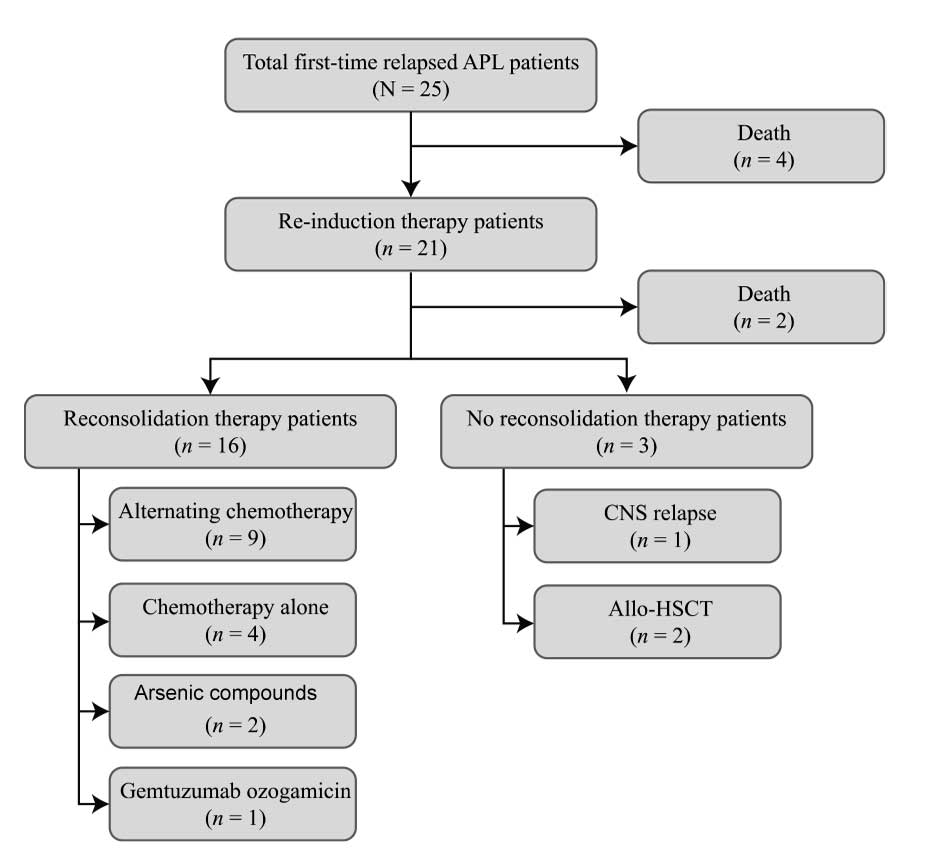|
1
|
Douer D, Preston-Martin S, Chang E,
Nichols PW, Watkins KJ and Levine AM: High frequency of acute
promyelocytic leukemia among Latinos with acute myeloid leukemia.
Blood. 87:308–313. 1996.
|
|
2
|
Vickers M, Jackson G and Taylor P: The
incidence of acute promyelocytic leukemia appears constant over
most of a human lifespan, implying only one rate limiting mutation.
Leukemia. 14:722–726. 2000. View Article : Google Scholar
|
|
3
|
Kelaidi C, Chevret S, De Botton S, et al:
Improved outcome of acute promyelocytic leukemia with high WBC
counts over the last 15 years: the European APL Group experience. J
Clin Oncol. 27:2668–2676. 2009.PubMed/NCBI
|
|
4
|
Sanz MA, Grimwade D, Tallman MS, et al:
Management of acute promyelocytic leukemia: recommendations from an
expert panel on behalf of the European LeukemiaNet. Blood.
113:1875–1891. 2009. View Article : Google Scholar : PubMed/NCBI
|
|
5
|
Degos L and Zhen YW: All trans retinoic
acid in acute promyelocytic leukemia. Oncogene. 20:7140–7145. 2001.
View Article : Google Scholar : PubMed/NCBI
|
|
6
|
Lo-Coco F, Avvisati G, Vignetti M, et al:
Front-line treatment of acute promyelocytic leukemia with AIDA
induction followed by risk-adapted consolidation for adults younger
than 61 years: results of the AIDA-2000 trial of the GIMEMA Group.
Blood. 116:3171–3179. 2010.
|
|
7
|
Fu S, Consoli U, Hanania EG, et al:
PML/RARalpha, a fusion protein in acute promyelocytic leukemia,
prevents growth factor withdrawal-induced apoptosis in TF-1 cells.
Clin Cancer Res. 1:583–590. 1995.
|
|
8
|
de The H, Chomienne C, Lanotte M, Degos L
and Dejean A: The t(15;17) translocation of acute promyelocytic
leukaemia fuses the retinoic acid receptor alpha gene to a novel
transcribed locus. Nature. 347:558–561. 1990.
|
|
9
|
Fenaux P, Chastang C, Chevret S, et al: A
randomized comparison of all transretinoic acid (ATRA) followed by
chemotherapy and ATRA plus chemotherapy and the role of maintenance
therapy in newly diagnosed acute promyelocytic leukemia. The
European APL Group. Blood. 94:1192–1200. 1999.
|
|
10
|
Callens C, Chevret S, Cayuela JM, et al:
Prognostic implication of FLT3 and Ras gene mutations in patients
with acute promyelocytic leukemia (APL): a retrospective study from
the European APL Group. Leukemia. 19:1153–1160. 2005. View Article : Google Scholar : PubMed/NCBI
|
|
11
|
Tallman MS, Andersen JW, Schiffer CA, et
al: All-trans retinoic acid in acute promyelocytic leukemia:
long-term outcome and prognostic factor analysis from the North
American Intergroup protocol. Blood. 100:4298–4302. 2002.
View Article : Google Scholar
|
|
12
|
Asou N, Kishimoto Y, Kiyoi H, et al: A
randomized study with or without intensified maintenance
chemotherapy in patients with acute promyelocytic leukemia who have
become negative for PML-RARalpha transcript after consolidation
therapy: the Japan Adult Leukemia Study Group (JALSG) APL97 study.
Blood. 110:59–66. 2007. View Article : Google Scholar
|
|
13
|
Breccia M, Cicconi L, Minotti C, et al:
Efficacy of prolonged therapy with combined arsenic trioxide and
ATRA for relapse of acute promyelocytic leukemia. Haematologica.
96:1390–1391. 2011. View Article : Google Scholar : PubMed/NCBI
|
|
14
|
Thirugnanam R, George B, Chendamarai E, et
al: Comparison of clinical outcomes of patients with relapsed acute
promyelocytic leukemia induced with arsenic trioxide and
consolidated with either an autologous stem cell transplant or an
arsenic trioxide-based regimen. Biol Blood Marrow Transplant.
15:1479–1484. 2009. View Article : Google Scholar
|
|
15
|
Ghavamzadeh A, Alimoghaddam K, Ghaffari
SH, et al: Treatment of acute promyelocytic leukemia with arsenic
trioxide without ATRA and/or chemotherapy. Ann Oncol. 17:131–134.
2006. View Article : Google Scholar : PubMed/NCBI
|
|
16
|
Ravandi F, Estey E, Jones D, et al:
Effective treatment of acute promyelocytic leukemia with
all-trans-retinoic acid, arsenic trioxide, and gemtuzumab
ozogamicin. J Clin Oncol. 27:504–510. 2009. View Article : Google Scholar : PubMed/NCBI
|
|
17
|
American Cancer Society Publications.
Leukemia-Acute Myeloid (Myelogenous): How is it classified?
http://www.cancer.org/cancer/leukemia-acutemyeloidaml/detailedguide/leukemia-acute-myeloid-myelogenous-classified.
Accessed April 15, 2012
|
|
18
|
de Botton S, Sanz MA, Chevret S, et al:
Extramedullary relapse in acute promyelocytic leukemia treated with
all-trans retinoic acid and chemotherapy. Leukemia. 20:35–41.
2006.
|
|
19
|
National Cancer Institute. Cancer therapy
evaluation program: Common toxicity criteria manual. Version 2.0.
1999.
|
|
20
|
National Comprehensive Cancer Network.
Clinical practice guidelines in oncology: Acute myeloid leukemia.
2011.
|
|
21
|
Nagai S, Takahashi T and Kurokawa M:
Beneficial and adverse effects of molecularly targeted therapies
for acute promyelocytic leukemia in central nervous system. CNS
Neurol Disord Drug Targets. 8:387–392. 2009. View Article : Google Scholar : PubMed/NCBI
|
|
22
|
Machner B, Neppert B, Paulsen M, Hofmann
C, Sander T and Helmchen C: Pseudotumor cerebri as a reversible
side effect of all-trans retinoic acid treatment in acute
promyelocytic leukaemia. Eur J Neurol. 15:e68–e69. 2008. View Article : Google Scholar : PubMed/NCBI
|
|
23
|
de Botton S, Fawaz A, Chevret S, et al:
Autologous and allogeneic stem-cell transplantation as salvage
treatment of acute promyelocytic leukemia initially treated with
all-trans-retinoic acid: a retrospective analysis of the European
acute promyelocytic leukemia group. J Clin Oncol. 23:120–126.
2005.
|
|
24
|
O’Brien S, Kantarjian HM, Keating M, et
al: Association of granulocytosis with poor prognosis in patients
with acute myelogenous leukemia and translocation of chromosomes 8
and 21. J Clin Oncol. 7:1081–1086. 1989.PubMed/NCBI
|
|
25
|
Kohno A, Morishita Y, Iida H, et al:
Hematopoietic stem cell transplantation for acute promyelocytic
leukemia in second or third complete remission: a retrospective
analysis in the Nagoya Blood and Marrow Transplantation Group. Int
J Hematol. 87:210–216. 2008. View Article : Google Scholar
|
|
26
|
Bourquin JP, Thornley I, Neuberg D, et al:
Favorable outcome of allogeneic hematopoietic stem cell
transplantation for relapsed or refractory acute promyelocytic
leukemia in childhood. Bone Marrow Transplant. 34:795–798. 2004.
View Article : Google Scholar
|











